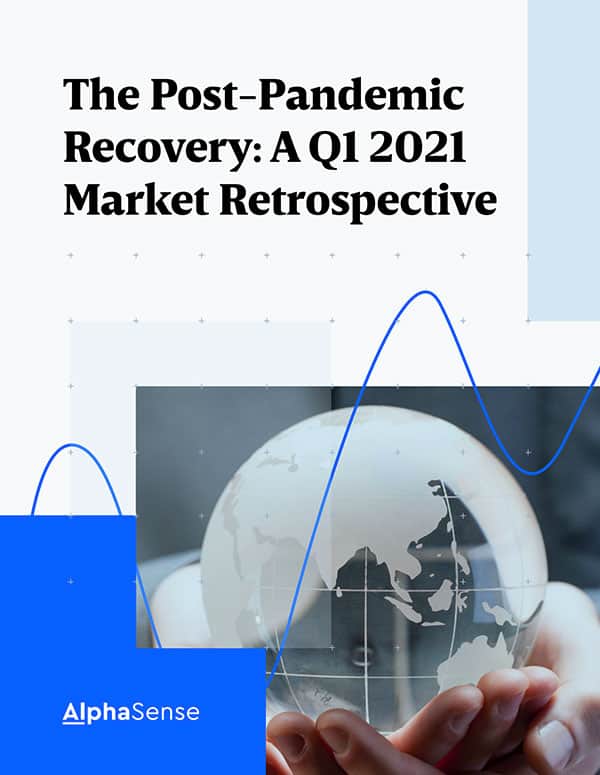As we finally emerge into a post-pandemic economy and a new set of norms, questions linger. Which workplace changes will be permanent? When will residual economic impacts of the pandemic finally subside? What do businesses and investors need to know to succeed in the coming months and years?
In this article, we cover key takeaways from research presented in partnership by AlphaSense and HSBC in an Expert Briefing Series on our post-pandemic economy and world. What follows are four important scenarios to watch in the coming months, years, and decades.
Inflationary pressures remain for the foreseeable future
In the United States, surging inflation has remained the largest lingering economic effect of the pandemic. Between May 2021 and 2022, the U.S. saw its most significant annual inflation rate increase since December 1981 at nearly 8.6%.
HSBC US Economist Ryan Wang attributes the intense inflation pressures we’re currently experiencing to two primary contributing factors: unrelenting high demand for products and an excess business demand for labor.
There was an unexpected increase in demand for goods that occurred in the latter half of 2020 (and hasn’t wavered since). In hindsight, it’s clear this boost came from savings spillovers after pandemic lockdowns and multiple federal stimulus payments. At the time, however, businesses and their suppliers were caught off guard.
Supply challenges continue to linger around the world, especially in the United States, as supply chains play catch up. And while product growth has begun to taper, it still solidly remains at an elevated level — 15% higher than pre-pandemic levels in 2019.
At the same time, job openings and voluntary turnover have been on an upward trajectory, and both still continue to grow. It has created a shifting bargaining dynamic between employees and businesses, resulting in faster wage growth across industries, particularly for lower-wage jobs. The result of this shifting bargaining dynamic has been increased costs for businesses, which ultimately puts the squeeze on consumers in the form of price hikes.
Today, the burning inflation question is two-pronged: Have inflation rates finally peaked? And if so, how long will they take to go down?
Earlier this month, the FOMC unexpectedly announced that they were increasing federal rates by three-quarters of a percentage point for the first time since 1994, indicating their real concern around persistent price gains and willingness to take aggressive action to tame them.
Still, the future is unclear.
FOMC Chairman Jerome Powell said himself after the June meeting that “there’s a much bigger chance now that [inflation] will depend on factors we don’t control.” HSBC predicts a potential scenario where elevated inflation rates may be part of the new normal, although not at the peak rates we’re seeing currently.
The takeaway: when it comes to inflation, it seems likely that rates have peaked, but we’re still very much in wait-and-see mode when it comes to long-term economic figures and impacts.
Workplace flexibility becomes permanent
Workplace flexibility is a factor with enormous implications, both demographically and economically, in our post-pandemic world. The working world experienced a shocking — and unexpectedly successful — transition to remote work in a matter of weeks.
Two years later, businesses are faced with permanently altered employee expectations around flexible work environments. Their challenge will be to meet those expectations in ways that enable them to retain top talent without compromising their ability to achieve business goals.
According to HSBC Global Economist James Pomeroy, it’s employees who wield the power in this evolving situation. In the UK, a full quarter of employees say they’ll quit their jobs if forced to return to the office full-time. In the United States, that number is %15, a bit lower but still significant. It’s not just about the money any longer for many working professionals. On average around the world, employees value workplace flexibility as much as a 5% pay raise.
Their argument is hard to dispute from a productivity standpoint. Research has shown people are more productive in hybrid models than fully in-person environments. Hybrid models work best when employees are given some choice around in-office vs. remote workdays.
And more and more businesses are getting on board. Hybrid models grew steadily throughout the entirety of 2021, with workers expecting to spend 28% of their fully-paid workdays at home by December of last year. Going forward, it’s likely we will see fully in-person work environments increasingly become the exception, while hybrid workplace models emerge as the new norm.
Cities compete to attract residents
A larger demographic effect of changing workplace environments has been a flight from big cities. No longer required to stay near urban work headquarters, people have sought more suburban and even rural living options and have stopped commuting into the city regularly.
There are obvious environmental benefits to this change — commuting is a huge contributor to carbon emissions in cities around the world. But for cities themselves, this presents another changing dynamic between businesses, employees, and consumers. HSBC’s Pomeroy indicated that while people aren’t commuting to work at the same volume or frequency as before, they are still going to cities to engage in leisure activities — bars, restaurants, sporting events, shows, and other forms of entertainment. This means cities still have an opportunity to attract residents, just by different means.
What Pomeroy predicts in a post-pandemic world is an exciting scenario where cities invest heavily in their livability and compete to become the best places to live in their regions. This means we could see more green spaces, small business investment, growing cultural experiences, improved public transportation and policing, and sporting events that attract people from all over the world.
With pioneering cities like Vienna and Melbourne serving as models, “future cities” will focus on optimum quality of living rather than corporate convenience.
Lower birth rates indicate population peak by 2050s
A bit separate from near-future scenarios like inflation and workplace changes — but important and impactful nonetheless — is the accelerated decrease in birth rates that occurred during the pandemic. In 2020 global birth rates fell to their lowest levels ever recorded.
Post-pandemic economic and geopolitical factors are still impacting birth rates in 2022, particularly in the developed world. Living expenses, climate change, and volatile political and social issues are all playing a role in people’s decisions to have fewer (or no) children.
According to HSBC research, this will lead to larger global demographic shifts, with Africa likely taking over as the world’s epicenter of population growth over the next few decades, and India overtaking China as the most populous country in the world. At the same time, we’ll likely see a global population peak by the 2050s.
A shrinking population is good news as it relates to many of the ESG-related issues the world has faced in modern times. For governments, however, an aging population means inevitable economic issues, like a squeeze on social security programs, increased healthcare and senior care costs, and a smaller labor workforce.
In the near future, expect birth rates in the Western world to stay low as people come to terms with new post-pandemic economic and demographic norms.
To remain resilient in unpredictable post-pandemic markets, it’s essential to stay ahead of emerging trends and the most important happenings across the investment world. In our four-part HSBC series, we cover market-moving trends like urbanization, demographics, and inflation, so you can keep your finger on the pulse.
To access the full webinars, visit:
- 2 Years into The Pandemic: The (New) Future of Work, Cities, and Demographics
- Inflation Strains: The Outlook for the US Economy
.png)






%20%7C%20AlphaSense&_biz_n=0&rnd=830321&cdn_o=a&_biz_z=1743182834510)
%20%7C%20AlphaSense&rnd=953462&cdn_o=a&_biz_z=1743182834514)
%20%7C%20AlphaSense&_biz_n=0&rnd=830321&cdn_o=a&_biz_z=1743182837511)